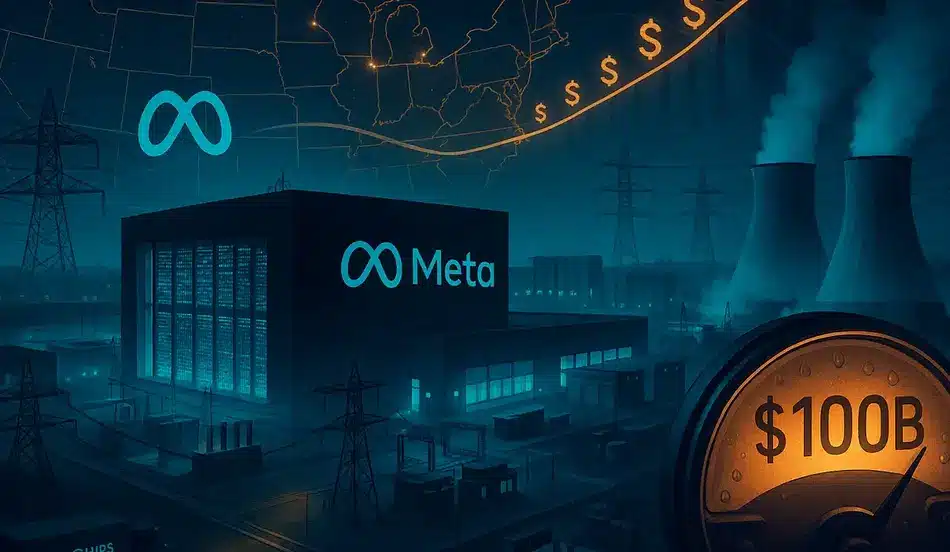In a move that’s shaking the global AI and cloud infrastructure market, Meta has unveiled an unprecedented $100 billion capital expenditure plan for 2026. This massive investment isn’t just about building more data centers—it’s about transforming the entire AI infrastructure ecosystem. From land acquisition to renewable power sourcing, Meta’s strategy reflects a broader trend among hyperscalers to become full-stack infrastructure providers.
The driving force? A surge in demand for AI compute power—especially generative AI—fueled by large language models (LLMs) and billions of user interactions every month. Google alone now processes a staggering 1 quadrillion tokens per month, underscoring just how mainstream generative AI has become.
The Vision Behind Meta’s Massive CapEx Plan
Beyond Just Physical Expansion
While building more data centers might seem like the obvious goal, Meta’s 2026 CapEx plan goes further. This investment covers the entire supply chain of AI infrastructure—from securing physical land to establishing long-term power supply agreements.
For Meta, this isn’t about owning the biggest facilities; it’s about creating an integrated, scalable, and sustainable infrastructure that can handle exponential AI workloads without compromising on efficiency or innovation.
Why This Matters for the AI Ecosystem
The scale of Meta’s investment sends a clear message: AI is no longer experimental—it’s a critical utility. Just as the internet revolution required vast server networks, today’s AI boom demands specialized, high-performance computing infrastructure that can scale seamlessly.
Read how AI in recruitment is reshaping hiring processes in 2025.
Partnerships: Meta’s Competitive Edge
Strategic Collaboration Over Complete Ownership
One of the most notable aspects of Meta’s expansion strategy is its reliance on partnerships. By collaborating with data center operators, land developers, and infrastructure financiers, Meta can leverage external expertise while keeping its own teams focused on AI software and algorithm development.
This approach allows Meta to:
- Reduce capital risk
- Speed up deployment timelines
- Secure more favorable energy contracts
The result? Faster innovation without the burden of managing every component internally.
Lessons from the Hyperscale Playbook
Other hyperscalers like Amazon Web Services and Microsoft Azure have used similar strategies to secure competitive advantages. By splitting responsibilities between infrastructure and application development, these companies avoid bottlenecks and ensure resources are directed where they have the highest impact.
Explore how top employers set hiring manager expectations in 2025.
The Scale of AI Demand: From Quadrillions to Billions
Google’s 1 Quadrillion Tokens per Month
If there’s a single statistic that captures the AI revolution’s magnitude, it’s this: Google processes over 1 quadrillion tokens per month in generative AI workloads. This equates to millions of interactions every second, each requiring sophisticated infrastructure to process in real time.
AI as a Mainstream Utility
Generative AI now has nearly 1 billion monthly active users. This adoption rate mirrors the early days of social media and smartphones, suggesting that AI-powered services are quickly becoming daily essentials for both individuals and enterprises.
Looking to Hire Fast?
Hiring managers can now post jobs for free on WhatJobs and connect with millions of jobseekers.
👉 Post a Job Now →Balancing Compute Growth with Sustainability
The Energy Dilemma
With great power comes great electricity bills—and environmental concerns. Scaling AI inference workloads to this degree requires vast energy resources. Critics question whether all this compute is justified, especially given global sustainability goals.
Productivity Gains as a Counterbalance
Supporters argue that the productivity benefits of AI offset some environmental costs. AI-assisted coding tools, for instance, allow developers to write code faster, debug more efficiently, and deliver products to market sooner. These efficiency gains have ripple effects across industries, potentially reducing waste and accelerating innovation.
Training vs. Inference: The Infrastructure Split
Understanding the Technical Divide
AI infrastructure isn’t one-size-fits-all. Training large models requires intensive, GPU-heavy compute clusters that can run for weeks or months. Inference, on the other hand, is about serving outputs to users in real time—which demands low-latency, high-availability systems.
Meta’s investment strategy reflects this split, ensuring both training clusters and inference-optimized systems receive adequate resources.
Emergence of New Players: Density II and Beyond
Startups Driving Infrastructure Innovation
The AI boom isn’t just benefiting hyperscalers. Companies like Density II, formed by alumni from Meta’s Dojo project, are bringing fresh ideas to AI infrastructure. These startups could offer new cooling systems, smarter workload orchestration, or energy efficiency breakthroughs that challenge existing designs.
Why This Matters for the Market
Competition from smaller, agile players can push giants like Meta to innovate faster and adopt more efficient technologies—potentially benefiting the entire AI industry.
The Future of AI Compute Infrastructure
Meta’s $100 billion bet signals a new era of infrastructure competition—one where efficiency, sustainability, and partnerships matter as much as raw computing power. As AI continues its march toward becoming an everyday utility, the companies that can scale responsibly while innovating quickly will lead the next decade of tech growth.
FAQs About Meta’s AI Data Center Expansion 2026
What is Meta’s AI Data Center Expansion 2026 plan?
Meta’s AI Data Center Expansion 2026 is a $100 billion investment to scale global AI compute power. It covers new data centers, land acquisition, renewable power sourcing, and infrastructure partnerships.
Why is the Meta AI Data Center Expansion 2026 significant?
The scale of investment reflects the exploding demand for AI compute power. With nearly 1 billion monthly active users of generative AI, Meta’s infrastructure ensures it can meet future workloads.
How will the Meta AI Data Center Expansion 2026 address sustainability concerns?
Meta plans to secure renewable power sources and partner with specialized infrastructure providers to improve efficiency, aiming to balance environmental impact with productivity gains.
What industries will benefit from the Meta AI Data Center Expansion 2026?
Industries ranging from healthcare and finance to retail and entertainment will benefit, as increased AI compute capacity enables faster, more advanced AI applications.




